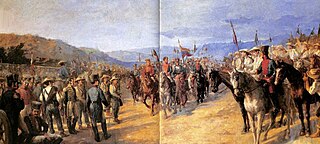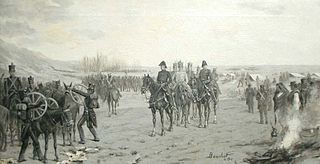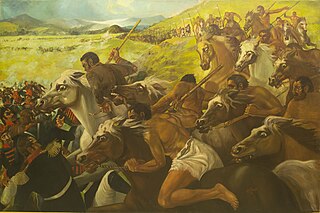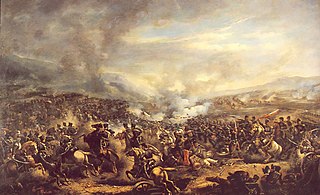
José Francisco de San Martín y Matorras, nicknamed "the Liberator of Argentina, Chile and Peru", was an Argentine general and the primary leader of the southern and central parts of South America's successful struggle for independence from the Spanish Empire who served as the Protector of Peru. Born in Yapeyú, Corrientes, in modern-day Argentina, he left the Viceroyalty of the Río de la Plata at the early age of seven to study in Málaga, Spain.

The Argentine War of Independence was a secessionist civil war fought from 1810 to 1818 by Argentine patriotic forces under Manuel Belgrano, Juan José Castelli, Martin Miguel de Guemes and José de San Martín against royalist forces loyal to the Spanish crown. On July 9, 1816, an assembly met in San Miguel de Tucumán, declaring independence with provisions for a national constitution.

Bolívar's campaign to liberate New Granada also known as the Liberation Campaign of 1819 was part of the Colombian and Venezuelan wars of independence and was one of the many military campaigns fought by Simón Bolívar. In 1819 Bolívar led a combined New Granadan and Venezuelan Army in a campaign to liberate New Granada which had been under Spanish control since 1816.

The Battle of Boyacá (1819), also known as the Battle of Boyacá Bridge was a decisive victory by a combined army of Venezuelan and New Granadan troops along with a British Legion led by General Simon Bolivar over the III Division of the Spanish Expeditionary Army of Costa Firme commanded by Spanish Colonel José Barreiro. This victory ensured the success of Bolívar's campaign to liberate New Granada. The battle of Boyaca is considered the beginning of the independence of the north of South America, and is considered important because it led to the victories of the battle of Carabobo in Venezuela, Pichincha in Ecuador, and Junín and Ayacucho in Peru. New Granada acquired its definitive independence from the Spanish Monarchy, although fighting with royalist forces would continue for years.

The Battle of Maipú was fought near Santiago, Chile on 5 April 1818, between South American rebels and Spanish royalists, during the Chilean War of Independence. The Patriot rebels led by Argentine general José de San Martín effectively destroyed the Spanish forces commanded by General Mariano Osorio, and completed the independence of the core area of Chile from Spanish domination.

The Battle of Chacabuco, fought during the Chilean War of Independence, occurred on February 12, 1817. The Army of the Andes of the United Provinces of the Río de la Plata, led by Captain–General José de San Martín, defeated a Spanish force led by Rafael Maroto. It was a defeat for the Captaincy General of Chile, the royalist government established after the division of the Viceroyalty of Peru.

The Battle of Cancha Rayada, was fought in Chile between South American patriots and Spanish royalists, during the Osorio's campaign in the South American wars of independence. The result was a defeat for the patriot forces, weeks later the patriots take their rematch at the Battle of Maipú.

The Crossing of the Andes was one of the most important feats in the Argentine and Chilean wars of independence, in which a combined army of Argentine soldiers and Chilean exiles invaded Chile crossing the Andes range separating Argentina from Chile, leading to Chile's liberation from Spanish rule.

The Army of the Andes was a military force created by the United Provinces of the Río de la Plata (Argentina) and mustered by general José de San Martín in his campaign to free Chile from the Spanish Empire. In 1817, it crossed the Andes Mountains from the Argentine province of Cuyo, and succeeded in its objective by dislodging the Spanish from the country.

Grand Marshal Juan Gregorio de las Heras was an Argentine soldier who took part in the Spanish American wars of independence and was also a governor of the province of Buenos Aires.

Las Heras is a department located in the north west of Mendoza Province in Argentina.
The 8th Mountain Infantry Brigade is a unit of the Argentine Army specialised in mountain warfare. The headquarters of the Brigade is based on Mendoza, Mendoza Province. Is formed by different types of mountain units:

The Battle of Vargas Swamp fought on July 25, 1819, was an engagement of Bolívar's campaign to liberate New Granada. The battle involved a joint Venezuelan and New Granadan army commanded by General Simón Bolívar against the III Division of the Spanish Royalist Army commanded by Colonel José María Barreiro. The Battle of Vargas Swamp is considered one of most important battles of the Colombian War of Independence as it cleared the path for the Patriot army to advance towards Santafé de Bogotá, while also demoralizing the Royalist troops. Vargas Swamp was also the bloodiest battle of the 1819 New Granadan liberation campaign.

Spanish Reconquest or just Reconquest is the name of a period of Chilean history that started in 1814 with the royalist victory at the Battle of Rancagua and ended in 1817 with the patriot victory at the Battle of Chacabuco.During this period, the defenders of the Spanish Empire reestablished their dominion in Chile after said country had separated itself from the Spanish Crown, installed its First National Government Board in 1810—the first institution of self-government in Chile, created its First Congress National in 1811 and subsequently elected its first supreme director, Francisco de la Lastra, in 1814.

The Battle of El Roble was fought on the Itata river, 17 October 1813, between the Chilean patriot general José Miguel Carrera and Spanish royalist forces under the command of Clemente Lantaño and Luis Urrejola. The surprise patriot victory at El Roble as a result of Bernardo O'Higgins' actions at the end of the day was to result in a change of patriot commander, and a severe split within the patriot movement.
The Battle of Curapalihue fought in Chile, was a minor encounter between South American rebels and Spanish royalists, during the South American wars of independence. The result was a defeat for the royalists.
The action of Juncalito was a military engagement of the Argentine War of Independence, previous to the Crossing of the Andes campaign.

The first siege of Callao was a prolonged military blockade of the Real Felipe Fortress in Callao by the Liberating Expedition of Peru under the command of General José de San Martín in July 1821 which culminated in the capitulation of Marshal José de La Mar in September of the same year, with him switching sides from the Royalist side to the Patriot side.
The Battle of Sopachuy was an armed confrontation that occurred on 12 June 1817 in the village of Sopachuy, some 120 kilometers southeast from the city of Chuquisaca, between a division of the Army of the North of the United Provinces of the Río de la Plata, commanded by Lieutenant Colonel Gregorio Aráoz de Lamadrid and a Spanish Royalist force commanded by Colonel José Santos de la Hera. The Royalists ware victorious.













